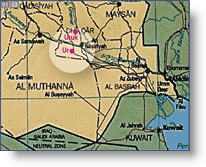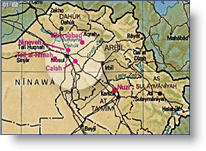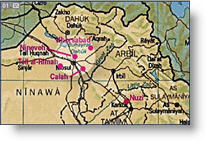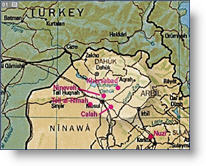What is the significance of Iraq in the Bible?
Iraq in the Bible
Early post-Flood civilization developed in Iraq (“the cradle of civilization”).
A very significant rebellion against God took place in Iraq, centered on the construction of the Tower of Babel (Genesis 10:8-97; 11:1-4): Story summary / Archaeological evidence.
The confusion of languages took place in Iraq - Genesis 11:5-11. (Prior to this event, there was apparently only one language in the world. To this day, we live with the far-reaching effects of this judgment of God.)
Abraham, the patriarch of the Jews and Muslims, came from a city in Iraq (Ur) - Genesis 11:31; Acts 7:2-4.
Isaac’s bride came from Iraq - Genesis 24:3-4, 10.
Jacob (Israel) spent 20 years in Iraq - Genesis 27:42-45; 31:38.
The first world empire formed in Iraq - Daniel 1:1-2; 2:36-38.
Various kings of Iraq were used by God to punish the children of Israel for turning away from Him.
The children of Israel spent much time in Iraq, as prisoners of war—as a punishment of God (Captivity).
The children of Israel returned to God in repentance in Iraq—and later returned to their promised land.
Perhaps the most amazing spiritual revival in history took place in a city in Iraq (Nineveh) - Jonah 3.
The events of the book of Esther took place in Iraq. With God’s help, she saved the Jews from a holocaust. This event is celebrated annually to this day (Purim).
The book of Nahum was a prophecy against a city in Iraq.
The book of Revelation contains prophecies against Babylon (one of Iraq’s former names) - Revelation 17-18.
No other nation, except Israel, has more biblical history and prophecy associated with it than Iraq.
Author: Paul S. Taylor
Christian Answers.
We are becoming increasingly familiar with the topography of Iraq as we watch TV news reports and read newspaper accounts of events unfolding there. Iraq, about the size of California, is ancient Mesopotamia, Greek for “in the midst of the rivers.” The rivers, the Tigris and Euphrates, played a key role in the development of civilization in this region.
The easternmost river, the Tigris, has its headwaters in eastern Turkey and flows past Mosul (ancient Nineveh), Tikrit, Baghdad, Kut and Basra. The Euphrates begins in east-central Turkey and flows past Karbala, Hilah (ancient Babylon) and Nasiriyah.
Iraq is called the “Cradle of Civilization,” as evidence has been found there for the earliest writing system, urban centers, literature, metallurgy, science, medicine and business, as reflected in the Bible (Genesis 2:14; 4:21–22; 10:10–11; 11:1–5). Our modern culture has its roots in ancient Iraq.
Biblical names for the southern part of ancient Mesopotamia [Iraq] include Shinar (ancient Sumer), Chaldea, and Babylon, and for the northern area, Assyria.
The ancient language of the region is called Akkadian, named after the city of Akkad, one of the cities founded by Nimrod in Shinar (Genesis 10:10). The language was written in cuneiform, or “wedge-shaped,” characters impressed into clay tablets with a wedge-shaped stylus.
There are tens of thousands of archaeological sites in this celebrated land. Starting in the south, we shall point out Biblical connections to some of the many discoveries that have been made in this country, so rich with ancient history and archaeological remains. These connections cluster around two time periods: the time of the Patriarchs, i.e., the Early Bronze and the first part of the Middle Bronze Ages, and the time of the Divided Monarchy, the Iron Age.
Ur
Located ten miles southwest of Nasiriyah, Ur is most famous as the hometown of Abraham. He migrated from Ur to Haran in southern Turkey, the actual homeland of the Patriarchs, and then to Canaan (Genesis 11:31; 12:1-5).
Evidence for a very advanced culture from Abraham’s day has been unearthed at Ur. Its restored ziggurat, or temple tower, is often shown in news reports. A temple to the moon god Nanna, or Sin, was situated on the top of the tower. The name of the Babylonian king Belshazzar (Daniel 5) appeared for the first time in a text found in a foundation deposit of the temple. Scholars once said the Bible was wrong in naming Belshazzar as king when the Persians conquered Babylon, since the known records indicated that Nabonidus was the last king of Babylon.
What the foundation deposit tablet, along with other subsequently found texts, revealed was that Belshazzar was the son of Nabonidus and coregent with his father. While Nabonidus was away campaigning, which he loved to do, Belshazzar was left to run the country from Babylon. Thus, Belshazzar offered Daniel the position of “third highest ruler in the kingdom” if he would decipher the handwriting on the wall (Dan. 5:16). This was the highest available office in the kingdom, since Nabonidus was number one and his son Belshazzar was number two. Instead of being in error, the Bible precisely reflected the political situation that existed in ancient Babylon at the time of its fall to the Medes and Persians.
Uruk (Erech)
Twenty-five miles east of Samawah is Uruk (Erech), another of the world’s earliest cities built by Nimrod (Gen. 10:10). Excavations there have shown that it indeed was one of the oldest cities in the world and a key city in the Sumerian culture.
Babylon
The expansive ruins of Babylon are located a few miles north of Hilah and about 25 miles south of Baghdad. Founded by Nimrod (Gen. 10:10), it was one of the most famous cities in the ancient world. Babylon was capital of the Babylonian empire that ruled the world from 612 to 539 BC.
Five of its kings are named in the Bible: Merodach-Baladan (2 Kings 20:12), Nebuchadnezzar II destroyer of Jerusalem in 586 BC (2 Kgs 24–25, etc.), Evil-Merodach (2 Kings 25:27-30; Jer. 52:3-34), Nergal-Sharezer (Jer. 39:3, 13) and Belshazzar (Dan. 5).
Many important finds have been made at Babylon, including the foundations of the “Tower of Babel” (Gen. 11:1-8), the royal palace built by Nebuchadnezzar where God pronounced judgment on the Babylonian Empire by means of the handwriting on the wall (Dan. 5), records detailing rations given to King Jehoiachin and his family who had been taken to Babylon as captives (2 Kings 24:15), the Babylonian Chronicle recording the capture of Jerusalem by Nebuchadnezzar March 16, 597 BC, and the Cyrus Cylinder describing the fall of Babylon (in fulfillment of Biblical prophecy) in 539 BC and the subsequent freeing of captives so they could return to their native lands as was the case with the Judeans (2 Chr 36:23; Ezra 1:2-4, 6:3-5).
Baghdad
One of the tragedies of the war in Iraq, and perhaps the greatest archaeological tragedy of all time, was the looting of the National Museum following the capture of Baghdad by U.S. forces. Mobs ransacked the museum, grabbing treasures dating back to the dawn of civilization in Mesopotamia. “They have looted or destroyed 170,000 items of antiquity…They were worth billions of dollars,” said deputy director Nabhal Amin, weeping. Some of the world’s most important ancient finds, chronicling the achievements of the Uruk, Sumerian, Babylonian, Assyrian, Persian and early Islamic civilizations were there.
Included were mankind’s earliest written documents, ancient mathematical texts, ancient sculptures and other works of art. Also the riches from the royal death pits at Ur from the late third millennium BC and tablets of the Gilgamesh Epic detailing a great flood with many elements similar to those of Noah’s Flood (building an ark, taking animals on board, releasing birds). Museums in other parts of the country were looted as well.
Nuzi
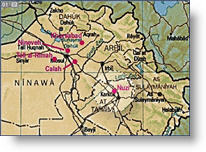
Located eight miles southwest of Kirkuk, the oil capital of the north, Nuzi was a center of the Hurrian culture. The Hurrians are called Horites, Hivites and Jebusites in the Bible.
About 3,500 tablets were found there dating from 1600 to 1400 BC. Many of the tablets deal with laws and customs and provide some of the best available evidence for the common social, economic and legal practices in the ancient world. Such things as a childless couple adopting a slave to be their heir (Gen. 15:2-3), having children by proxy (Gen. 16:1-2), deathbed blessings (Gen. 27, 48–49) and the importance of household gods (Gen. 31:19, 30) are illuminated in the texts.
Calah
Calah, 20 miles southeast of Mosul, is one of three cities referred to as the “Assyrian Triangle.” Along with Nineveh and Khorsabad, Calah was an important center of the Assyrian Empire that flourished ca. 900–612 BC.
Nimrod built it when he went from Shinar to Assyria (Gen. 10:10-11). Two Assyrian kings mentioned in the Bible ruled from Calah: Tiglath-Pileser III, also called “Pul” (2 Kgs 15:19, 29; 16:7, 10) and Shalmaneser V (2 Kings 17:3-6, 24; 18:9).
The ruins of the palace of Tiglath-Pileser III were found, including his annals recording his campaigns to Israel mentioned in 2 Kings 15:19-20 (740 BC) and 2 Kings 15:29 (732 BC).
In addition, three Israelite kings who paid him tribute are named (Menahem, Pekah and Hoshea), as well as one king of Judah (Ahaz). A prize find was made in the palace of Shalmaneser III—the so-called “Black Obelisk”—that depicts Jehu, king of Israel, bowing before Shalmaneser III as he presents tribute.
Tell al-Rimah
In 1967, a stela of the Assyrian king Adad-nirari III was found at Tell al-Rimah, 40 miles west of Mosul. It records a campaign to the west in which Adad-nirari received tribute from Jehoash king of Israel.
Nineveh
Located in northern Iraq at the modern city of Mosul, Nineveh was also founded by Nimrod (Genesis 10:11). Walls nearly eight miles long enclose an area of 1,700 acres.
There were outlying suburbs as well, so that when Jonah went there in the early eighth century BC, it took him three days to traverse the city (Jon 3:3).
Although Nineveh repented at Jonah’s preaching (Jon 3:5) the revival was short-lived. The Assyrians were soon back to their cruel practices, and God ultimately brought the empire to an end, as predicted by the prophets Nahum and Zephaniah.
Nineveh was most famous as the capital city of Sennacherib, the greatest of the Neo-Assyrian kings. Portions of his fabulous palace covering three large city blocks have been excavated. Painted sculptured reliefs depicting his exploits lined the walls. Many records were also found.
The Bible tells of Sennacherib’s campaign against Judah in 701 BC (2 Kgs 18:18-19:36). In the Assyrian version, Sennacherib states that he shut Hezekiah in Jerusalem, “like a bird in a cage.” He could not boast of capturing Jerusalem because an angel of the Lord decimated his army, and he was forced to return to Nineveh (2 Kings 19:35–36).
His most significant accomplishment in 701 was the defeat of Lachish (2 Kings 18:14, 17; 19:8). One entire room in Sennacherib’s palace was devoted to this event. The walls were lined with reliefs, now in the British Museum in London, depicting the city and the battle. Sennacherib is seen seated on a throne reviewing a procession of captives and booty being brought out of the city.
The next two kings, Esarhaddon and Ashurbanipal, are also referred to in the Bible at 2 Kings 19:37 and Ezra 4:10, respectively. Their records mention Manasseh king of Judah. He supplied building materials for Esarhaddon’s palace at Nineveh and troops for Ashurbanipal’s invasion of Egypt.
One of the most significant finds at Nineveh was the library of Ashurbanipal which comprised about 1,500 different texts, some with multiple copies, including archival, literary, magical, medical, divinatory and ritual tablets. It was here that the famous Epic of Gilgamesh, with its flood story, was first discovered.
Khorsabad
At Khorsabad, 15 miles northeast of Mosul, is the site of Dur Sharrukin, “fortress of Sargon,” ruler of the Assyrian Empire 721–705 BC. Prior to 1847, Sargon was known only from Isaiah 20:1, where it says, “In the year that the supreme commander, sent by Sargon king of Assyria, came to Ashdod and attacked and captured it.”
Since his name did not appear in classical sources, scholars concluded that the Sargon in the Bible was not a bona fide king, but rather an alias for some other Assyrian ruler. Ironically, Sargon was the first name of an Assyrian king to be read from Assyrian inscriptions when, in 1847, his vast palace of more than 200 rooms and 30 courtyards, with sculptured reliefs and written records, was excavated at Khorsabad.
Sargon campaigned in the Palestine region three times, 720, 716/715 and 712/711 BC, turning Israel into an Assyrian province and Judah into a vassal state in the process.
In 720 BC, following the initial defeat of Samaria by his predecessor Shalmaneser V, Sargon boasted of deporting 27,280 Israelites to Assyria. In 712/711 BC, he turned his attention to Ashdod and the area of Philistia. According to Isaiah 20:1, he sent his commander-in-chief (tartan) to capture the city. Assyrian records verify that Sargon remained in his capital at Khorsabad, stating that he stayed “in the land,” no doubt to supervise the construction of his palace.
The Future of Iraq

What lies ahead for Iraq? In the short term, we pray for a quick end to hostilities, and peace, stability and prosperity for the Iraqi people. In the long term, God said through the prophet Isaiah,
“In that day there will be a highway from Egypt to Assyria. The Assyrians will go to Egypt and the Egyptians to Assyria. The Egyptians and Assyrians will worship [the Lord] together. In that day Israel will be the third, along with Egypt and Assyria, a blessing on the Earth. The Lord Almighty will bless them, saying, ‘Blessed be Egypt My people, Assyria My handiwork, and Israel My inheritance’” (Is 19:23-25).
Author: Dr. Bryant G. Wood of Associates for Biblical Research.
Copyright © 2005, Associates for Biblical Research, All Rights Reserved.
More information
- About idolatry and false gods in the Bible
- What is the Tower of Babel? and why is it important in world history?
- TOWER OF BABEL—Is there archaeological evidence of it? Answer
- Babel’s confusion of languges—Is there any reference to this event in early Mesopotamian literature?
- Confusion of Tongues
- Summary of the biblical story of the Tower of Babel (God’s Story)
- Who is Nimrod?
- Babylon
- Chaldea
- The land of Shinar
- Cush (land and father of Nimrod)
- Accad (Akkad) (one of Nimrod’s cities)
- Calah (one of Nimrod’s cities)
- Calneh (one of Nimrod’s cities)
- Erech (one of Nimrod’s cities)
- Nimrud (one of Nimrod’s cities)
- Nineveh (one of Nimrod’s cities)
- Resen (one of Nimrod’s cities)
- ORIGIN OF ETHNIC PEOPLE GROUPS—How could all ethnicities from Noah, his three sons and their wives? Answer
- Genesis and ancient Near Eastern stories of Creation and the Flood: an introduction
- Dispersion—from the plain of Shinar
- Peleg
- Who is Jonah and what did he do?
- What are the CITIES of the Bible? Names, descriptions, locations and types
ChristianAnswers.Net grants generous rights for educational use of this page in homes, personal witnessing, churches and schools. See: “Usage and Copyright”.
